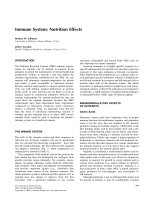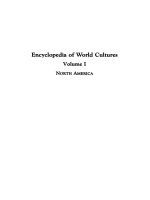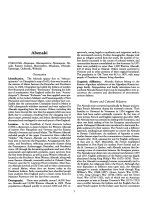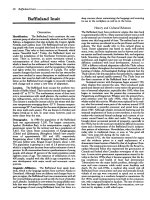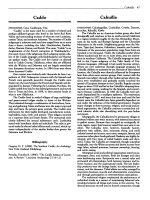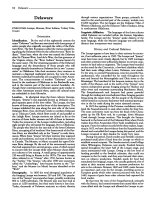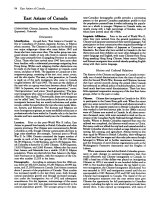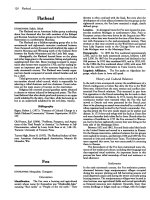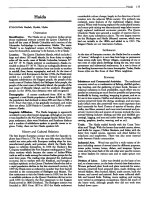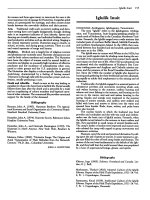Encyclopedia of World CulturesVolume I - NORTH AMERICA - D ppt
Bạn đang xem bản rút gọn của tài liệu. Xem và tải ngay bản đầy đủ của tài liệu tại đây (1.16 MB, 10 trang )
84
Delaware
Delaware
ETHNONYMS:
Lenape,
Munsee,
River
Indians,
Turkey
Tribe,
Unami
Orientation
Identification.
By
the
end
of
the
eighteenth
century
the
name
'Delaware"
had
become
associated
with
three
groups
of
native
people
who
originally
occupied
the
valley
of
the
Dela-
ware
River.
The
first
Europeans
called
the
various
people
liv-
ing
along
the
Delaware
River
by
the
collective
term
"River
In-
dians."
Years
later,
when
the
river
was
named
the
Delaware
after
Sir
Thomas
West,
Lord
de
la
Warr,
the
first
governor
of
the
Virginia
colony,
the
"River
Indians"
became
known
by
the
same
name.
The
few
remaining
speakers
of
the
Delaware
language
and
the
descendants
of
these
people
who
still
strongly
identify
themselves
as
Delaware
live
in
two
'commu-
nities"
in
Oklahoma.
Like
their
ancestors,
they
continue
to
maintain
a
dispersed
residential
pattern,
but
now
the
areas
between
individual
households
are
occupied
by
other
Ameri-
cans.
The
concentrations
of
modem
"Delaware"
can
be
found
in
the
northeast
of
Oklahoma
in
the
Bartlesville
area,
and
in
the
western
part
of
the
state
around
Anadarko.
Al-
though
these
contemporary
Delaware
appear
quite
similar
to
the
other
Americans
around
them,
many
old
cultural
traits
are
embedded
in
their
life-styles.
Location.
In
aboriginal
times
the
three
cultures
(Lenape,
Munsee,
"Jerseys")
now
popularly
known
as
Delaware
occu-
pied
separate
parts
of
the
river
valley.
The
Lenape,
the
best
known
of
these
groups,
are
the
focus
of
this
description.
The
Lenape
inhabited
the
area
along
the
west
side
of
the
lower
Delaware
River,
from
old
Duck
Creek
in
northern
Delaware
up
to
Tohiccon
Creek,
which
flows
south
of
and
parallel
to
the
Lehigh
River.
Lenape
territory
ran
inland
as
far
as
the
sources
of
these
feeder
streams
and
all
of
those
in
between.
Today
the
remnants
of
the
Lenape
traditionalists,
including
eight
people
who
still
speak
the
language,
live
in
Oklahoma.
The
people
who
lived
on
the
east
side
of
the
lower
Delaware
River,
occupying
all
of
southern
New
Jersey
south
of
the
Rar-
itan
River,
are
identified
only
as
the
"Jerseys"
in
early
docu-
ments.
When
these
"Jerseys"
left
their
territory
they
migrated
north
and
northwest,
and
most
of
their
descendants
now
live
in
Canada.
The
Munsee,
or
Minsi,
occupied
the
upper
Dela-
ware
River
drainage.
By
the
end
of
the
seventeenth
century
they
had
separated
into
several
groups,
some
of
which
moved
in
concert
with
the
Lenape
while
other
Munsee
chose
differ-
ent
cultures
to
live
among.
A
small
group
of
approximately
250
was
still
living
in
Kansas
in
the
1970s.
The
true
Lenape,
often
referred
to
as
"Unami"
after
1750,
became
known
as
the
"Turtles."
The
"Jerseys,"
who
after
1780
were
sometimes
called
the
"Unalachtigo,"
later
became
known
as
the
"Tur-
keys,"
and
the
Munsee
(or
Minsi)
became
identified
as
the
"Wolf."
Demography.
In
1600
the
total
aboriginal
population
of
the
foraging
Lenape
was
between
250
and
500.
The
popula-
tion
of
the
"Jerseys"
was
somewhat
larger,
possibly
numbering
800
to
1,000
individuals.
The
Munsee
also
may
have
had
as
many
as
1,000
members,
but
their
early
history
is
less
clear.
Today,
thousands
of
Delaware
maintain
an
ethnic
identity
through
various
organizations.
These
groups,
primarily
lo-
cated
in
the
south-central
part
of the
country,
include
over
25,000
members.
The
two
largest
are
the
Delaware
Tribe
of
Western
Oklahoma
and
the
Delaware
Tribe
of
Indians,
living
in
northeastern
Oklahoma.
Linguistic
Affiliation.
The
languages
of
the
three
cultures
called
Delaware
are
included
within
the
Eastern
Algonkian
family.
The
Lenape
and
the
"Jerseys"
spoke
dialects
of
the
same
language,
while
the
Munsee
language
was
sufficiently
distinct
that
interpreters
were
required.
History
and
Cultural
Relations
The
Lenape
appear
to
have
been
in
their
territory
for
centur-
ies,
if
not
millennia,
prior
to
1500.
The
Lenape
and
"Jerseys"
must
have
been
more
closely
aligned,
but
by
1600
marriages
and
other
activities
were
sufficiently
distinct
to
prevent
coop-
eration
in
land
sales
or
migration.
The
Lenape
were
bounded
on
the
south
by
the
Cinconicin,
a
low-level
chiefdom
which
had
their
main
village
where
Lewes,
Delaware,
now
stands.
To
the
west,
in
central
Pennsylvania,
were
the
powerful
Sus-
quehannock,
who
controlled
the
fur
trade
throughout
the
area
and
beyond
the
Monongahela
and
Ohio
rivers
to
the
Mississippi.
The
heartland
of
the
Iroquois
territory
lay
to
the
north
of
the
Munsee,
and
to
the
north
of
the
'Jerseys"
were
various
independent
groups
foraging
along
the
Hudson
and
other
rivers
and
waterways
surrounding
Manhattan
Island.
The
Susquehannock
and
Iroquois
had
grown
powerful
through
fur
trading
and
overshadowed
these
foraging
peoples
living
along
the
major
rivers.
All
the
people
of
the
Delaware
valley
formed
an
economic
backwater
with
minimal
participa-
tion
in
the
fur
trade
during
the
entire
sixteenth
century.
In
1622
the
uprising
of
the
Potomac
confederacy
stimu-
lated
the
Susquehannock
to
seek
other
outlets
for
their
furs.
The
most
convenient
route
ran
from
the
head
of
the
Chesa-
peake
up
the
Elk
River
and,
by
a
portage,
down
Minquas
Creek
through
Lenape
territory.
This
brought
the
Susque-
hannock
to
the
lower
end
of
the
Delaware
River
where
Dutch
traders
from
New
Amsterdam
(New
York)
established
a
trad-
ing
post.
From
the
earliest
records
left
by
these
traders,
begin-
ning
in
1623,
we
have
clear
evidence
that
the
Susquehannock
abused
and
controlled
the
Lenape
during
this
period,
and
the
Lenape
remained
in
their
shadow
for
nearly
forty
years.
During
this
period,
Dutch
traders
and
Swedish
colonists
purchased
small
plots
of
land
from
the
Lenape
on
which
to
establish
several
outposts.
The
Swedes
erected
a
small
village
where
Wilmington,
Delaware,
now
stands.
Swedish
farmers
spread
throughout
the
lower
half
of
the
Lenape
range,
and
many
intermarried
with
Lenape.
Owing
to
the
low
level
of
funding
provided
to
the
Swedish
colonists,
they
could
not
compete
in
the
fur
trade,
and
they
soon
focused
their
atten-
tion
on
tobacco
production.
Swedish
needs
for
food
had
stimulated
the
foraging
Lenape,
who
usually
gardened
a
bit
of
maize
at
their
summer
stations,
to
increase
production
for
sale
to
the
colonists.
Between
1640
and
1660,
maize
became
an
important
cash
crop
for
the
Lenape,
providing
access
to
European
goods
which
other
nations
procured
with
furs.
By
1660,
imports
of
grain
from
other
colonies
had
captured
the
local
market.
By
that
time
the
wars
of
the
Susquehannock,
primarily
with
the
Seneca,
had
created
stresses
that
caused
them
to
be-
come
allied
with
the
Lenape
and
allowed
the
Lenape
to
par-
Delaware
85
ticipate
more
extensively
in
the
fur trade.
When
English
im-
migrants
began
settling
the
area
around
1660
they
also
made
small
purchases
of
land
from
the
Lenape
on
which
to
estab-
lish
farms.
These
immigrants
stimulated
the
formation
of
new
alliances
in
the
region.
In
1674
the
Maryland
colonists
joined
with
the
Seneca
and
turned
on
the
Susquehannock,
who
had
formerly
been
their
allies.
The
Susquehannock
nation
was
de-
feated
and
scattered,
and
their
power
lost
forever.
Their
lands
in
central
Pennsylvania
and
to
the
west
be-
came
available
for
Lenape
use,
although
the
Maryland
colony
and
some
of
the
Five
Nations
now
held
claim
to
them
by
right
of
conquest.
Lenape
became
increasingly
active
in
the
fur
trade,
and
a
growing
number
relocated
into
this
vast
open
area
which
in
1680
was
uncluttered
by
European
immigrants.
The
political
events
that
led
the
English
Crown
to
grant
a
charter
for
this
region
to
William
Penn
(1681)
at
first
had
lit-
tle
significance
for
the
Lenape.
Penn's
policy
for
just
treat-
ment
of
the
native
peoples
led
him
to
contact
every
Lenape
band
and
to
purchase
all
their
holdings
in
the
Delaware
val-
ley.
This
program
began
in
1681
and
continued
until
1701.
Although
Penn
assiduously
protected
Lenape
rights
to
lands
on
which
they
were
seated,
the
foraging
life-style
depended
on
access
to
forest
resources
and
to
the
abundant
fish
runs
in
the
streams
feeding
the
Delaware
River.
Gradually
the
various
Lenape
bands
relocated
their
foraging
areas
and
summer
sta-
tions
farther
inland,
and
by
1750
all
the
Lenape
bands
had
re-
located
to
the
west
of
their
homeland,
joining
their
kin
who,
in
some
cases,
had
moved
west
more
than
fifty
years
previ-
ously.
Many
of
those
who
had
left
in
the
1600s
had
moved
even
farther
to
the
west
by
1740,
where
they
bought
lands
from
other
Native
American
groups.
This
established
a
pat-
tern
of
movement
in
which
the
Lenape
made
purchases
di-
rectly
from
aboriginal
landholders
and
later
sold
these
lands
to
colonists
or,
after
1780,
to
the
U.S.
government.
Over
the
years
various
Lenape
bands
established
settle-
ments
and
villages
in
Ohio,
Indiana,
Illinois,
Kansas,
and
even
Texas.
Innumerable
Lenape
splinter
groups
moved
into
still
other
areas,
and
many
individuals
simply
settled
down
among
and
married
with
the
immigrants
who
were
advancing
close
behind
them.
In
the
second
half
of
the
nineteenth
cen-
tury
most
of
the
Lenape
then
in
Kansas
made
a
purchase
of
land
(sometimes
seen
as
land
rights)
from
the
Cherokee
in
Indian
Territory,
which
later
became
Oklahoma.
Lenape
set-
tlements
among
those
of
the
western
Cherokee
provided
a
stable
environment,
but
one
increasingly
susceptible
to
out-
side
influences.
By
the
1920s
most
of
the
Lenape
had
come
to
speak
English,
and
fewer
households
were
to
be
found
where
the
Lenape
language
was
maintained.
Settlements
The
foraging
Lenape
had
no
permanent
settlements
and
no
villages,
and
the
"Jerseys"
in
the
historic
period
may
have
had
a
similar
settlement
pattern.
The
Munsee
built
small
villages
similar
to
those
of
the
Iroquois.
Each
Lenape
band
dispersed
into
nuclear
family
units
for
winter
hunting.
In
the
spring
these
families
regathered
at
a
summer
station
near
the
mouth
of
the
stream
that
served
as
the
focus
of
their
band's
territory.
About
a
dozen
such
bands
can
be
recognized,
each
averaging
nearly
twenty-five
members.
All
the
various
Lenape
bands
gathered
in
late
fall
for
annual
renewal
rites,
just
before
dis-
persing
for
winter
hunting.
Families
or
individuals
often
oper-
ated
alone
even
in
aboriginal
times,
and
after
1675
this
pat-
tern
of
independence
and
entrepreneurial
activity
became
pronounced.
From
several
historic
descriptions
we
know
that
each
ab-
original
Lenape
family
lived
in
a
wigwam,
less
than
nine
feet
in
diameter
and
under
five
feet
high.
The
walls
were
formed
from
thin
bent
poles
tied
at
the
top.
These
were
covered
with
bark
and
grass,
as
well
as
with
mats
woven
from
reeds.
A
hearth
area
occupied
the
center
of
the
floor
area.
Such
shel-
ters
must
have
served
the
Lenape
traditionalists
well
into
the
nineteenth
century,
although
those
Lenape
who
were
becom-
ing
more
sedentary
were
building
cabins
as
early
as
the
late
eighteenth
century.
Economy
Subsistence
and
Commercial
Activities.
The
Lenape
were
foragers
with
a
seasonal
pattern
of
band
aggregation
and
dispersion
geared
to
effective
recovery
of
naturally
available
resources
within
their
range.
In
the
early
spring
they
set
up
their
summer
stations
to
take
advantage
of
six
species
of
ana-
dromous
fish
which
spawned
in
the
fresh
waters
of
the
Dela-
ware
valley
watershed.
In
March
the
shad
were
the
first
of
these
to
arrive
from
the
sea,
with
a
run
often
lasting
as
long
as
four
weeks.
The
other
five
species
came
in
sequence
through-
out
the
summer
and
into
early
fall,
with
the
last
species
spawning
in
September
and
October.
These
fish,
plus
the
catadromous
eel
and
migratory
waterfowl
resources,
provided
an
abundant
and
extremely
rich
protein
source
for
nearly
eight
months
of
the
year.
The
winter
months,
during
which
deer
hunting
was
the
principal
activity,
were
less
rich,
but
suf-
ficient
to
supply
the
population
with
food
needs
when
supple-
mented/by
extensive
gathering.
Aside
from
the
period
from
1640
tcl
1660
when
Lenape
bands
cash-cropped
maize,
com-
plex
technology
was
available
only
through
the
sale
of
a
few
furs
and
the
barter
of
venison
and
other
native-made
prod-
ucts.
After
1680
the
Lenape
became
important
in
the
fur
trade,
but
the
demand
for
this
resource
had
declined.
Lenape
became
known
as
expert
and
reliable
guides
and
were
impor-
tant
in
opening
the
frontier
straight
out
to
the
Pacific
Coast.
Lenape
adoption
of
the
horse
in
the
eighteenth
century
facili-
tated
their
movement
west,
and
they
also
became
horse
trad-
ers
of
note.
The
independence
and
individuality
that
characterized
the
foraging
ancestors
of
these
people
are
reflected
today
in
a
number
of
economic
factors.
Private
ownership
of
their
own
homes,
a
reluctance
to
be
part
of
big
businesses,
and
avoid-
ance
of
financial
encumbrances
make
the
Delaware
appear
to
be
secure
members
of
the
American
mainstream.
Although
many
collectively
receive
government
payments
for
old
treaty
obligations,
there
are
none
of
the
difficulties
that
are
noted
among
other
Native
American
groups
where
such
support
has
become
the
mainstay
of
the
economy.
Industrial
Arts.
The
aboriginal
Lenape
were
extraordinar-
ily
skilled
at
leather
and
quillwork
and
at
carving
wooden
ob-
jects
that
were
often
traded
to
the
colonists.
Outstanding
early
examples
of
these
crafts
exist
in
European
museum
col-
lections.
Basketry
was
one
of
the
skills
used
by
Lenape
settled
among
the
seventeenth-century
colonists,
but
aspects
of
this
skill
may
have
been
European
imports.
Much
later,
ribbon-
work
applique
became
a
major
technique
for
decorating
86
Delaware
clothing
among
the
Lenape
as
it
did
among
many
other
Na-
tive
American
peoples.
Trade.
The
Lenape
always
maintained
a
relatively
low
level
of
trade,
both
with
their
aboriginal
neighbors
and
with
the
later
European
colonists.
Although
industrially
produced
metals,
cloth,
guns,
and
glass
were
immediately
of
interest
to
the
Lenape,
their
low
level
of
demand
never
generated
a
large-
scale
trading
dependence
as
was
often
the
case
with
other
na-
tive
cultures.
Division
of
Labor.
The
women
of
the
matrilineal
Lenape
performed
traditional
female
roles
and
did
whatever
garden-
ing
was
done
at
their
summer
stations,
including
preparing
the
small
plots.
Their
gathering
also
included
nestlings
and
eggs,
and
they
shared
in
harvesting
fish
during
the
big
runs.
Men
focused
on
fishing
and
were
of
greater
economic
impor-
tance
during
the
winter
hunting
when
they
provided
most
of
the
winter
food
supply.
These
male
roles
expanded
over
the
years
as
men
became
full-time
trappers,
guides,
scouts,
and
horse
traders.
Land
Tenure.
Land
usage
was
held
in
common
among
all
the
members
of
the
band,
which
could
be
equated
with
the
core
members
of
the
lineage
and
their
in-marrying
spouses.
The
aboriginal
lands
were
sold
by
each
of
these
bands,
with
all
the
adult
males
(over
thirteen
or
fourteen
years
of
age)
signing
the
land
transfer
documents.
After
1740
most
of
these
groups
held
land
in
common
among
much
larger
social
units,
equated
with
towns.
Land
sales
were
made
by
these
larger
groups,
and
sometimes
by
a
series
of
these
groups
act-
ing
as
a
single
political
body.
Kinship
Kin
Groups
and
Descent.
The
Lenape
bands
were
matril-
ineally
related
clusters
of
nuclear
families,
but
with
high
interband
mobility.
The
"clans"
of
the
Delaware
described
after
1750,
sometimes
referred
to
as
"phratries,"
reflected
the
three
cultures
living
in
the
Delaware
valley
prior
to
1700.
By
the
early
nineteenth
century,
these
cultures
had
become
iden-
tified
as
being of
three
'totemic
clans,"
still
reflecting
their
traditional
cultural
borders.
Kinship
Terminology.
Both
the
Lenape
and
jerseys
seem
to
have
used
Hawaiian
cousin
terminology
by
the
early
nine-
teenth
century
and
semibifurcate
terminology
for
the
first
as-
cending
generation.
This
had
evolved
from
the
earlier
aborigi-
nal
system,
which
remains
to
be
clarified.
Marriage
and
Family
Marriage.
The
traditional
groups
were
lineage
exogamous,
and
residence
was
matrilocal.
Polygamy
was
permitted,
but
after
contact
women
seem
to
have
preferred
to
marry
or
live
among
the
colonists
rather
than
to
become
secondary
wives.
Divorce
was
common
and
could
be
initiated
by
either
party.
Domestic
Unit.
Nuclear
families
have
always
been
the
rule
among
the
Lenape.
Inheritance.
In
the
1600s
most
of
a
person's
belongings
were
placed
in
the
grave.
By
1700
the
relatives
contributed
food
to a
feast
and
secured
goods
to
bury
with
the
deceased
as
well
as
to
distribute
to
participants
in
the
burial
rituals,
not
all
of
whom
were
close
kin.
Socialization.
Children
were
seldom
punished.
Low-level
social
controls
plus
the
rigors
of
foraging
life
provided
suffi-
cient
behavioral
controls
in
the
past.
Sociopolitical
Organization
Social
Organization.
In
aboriginal
times
the
egalitarian
Lenape
generally,
but
not
always,
equated
status
with
age.
Political
Organization.
The
independent
and
highly
fluid
aboriginal
bands
became
more
politically
united
after
1750,
with
towns
being
named
for
individuals
who
were
in
effect
chiefs.
Social
Control.
The
Lenape
have
always
avoided
conflict:
any
situation
that
could
produce
stress
is
called
kwulacan.
Even
in
the
face
of
changing
economics
and
modem
seden-
tary
life-styles,
Lenape
withdraw
from
controversy
and
diffi-
culties
on
any
level.
Conflict.
Withdrawal
from
problematical
situations
has
characterized
the
Lenape
since
they
were
first
described
by
Europeans.
This
encouraged
the
fissioning
of
social
groups
and
a
tendency
to
avoid
acting
as
a
single
political
entity.
The
history
of
the
Lenape,
as
with
some
of
their
neighbors,
has
been
a
series
of
splits
among
groups,
with
each
group
or
even
family
then
operating
as
an
independent
unit.
Such
groups
often
fused
with
others
in
complex
patterns
that
render
the
collective
history
of
these
people
difficult
to
follow.
Religion
and
Expressive
Culture
Religious
Beliefs.
The
aboriginal
Lenape
were
animistic,
but
individuals
held
strong
beliefs
about
the
unity
of
all
living
as
well
as
inanimate
things.
By
1800
the
Lenape
had
adopted
many
Munsee
and
Christian
beliefs.
Today,
most
practice
various
Protestant
religions,
but
many
still
retain
a
funda-
mentally
animist
worldview
largely
indistinct
from
that
which
their
distant
ancestors
would
have
found
appropriate.
Many
Europeans
interpreted
the
Manitou
of
the
Lenape
to
be
a
su-
preme
deity.
Various
other
beings,
particularly
those
associ-
ated
with
the
creation
myth,
suggest
that
"Manitou"
may
have
been
a
generic
term
applied
to
spirits
of
all
kinds.
Religious
Practitioners.
No
individuals
held
strong
ritual
power,
but
some
people
were
blessed
with
the
ability
to
heal.
Ceremonies.
The
complex
rituals
held
before
going
on
their
winter
hunting
rounds
were
associated
with
annual
re-
newal
gatherings.
These
became
still
more
complex
as
the
Lenape
adopted
increasing
numbers
of
introduced
behaviors,
particularly
as
they
became
more
sedentary.
Medicine.
Illness
could
be
dispersed
by
driving
out
spirits
that
caused
disease.
Specially
designated
curers
assisted
in
this
process,
aided
by
herbal
remedies
and
the
powers
of
col-
lective
chants
and
prayers.
Death
and
Afterlife.
Death
was
caused
by
evil
spirits,
and
the
polluted
dead
were
buried
in
graves
lined
with
rushes,
bark,
and
mats
several
hundred
meters
from
their
summer
en-
campments.
Complex
funeral
ceremonies
involved
transpor-
tation
of
the
corpse
to
a
prepared
burial
site,
ritual
lamenta-
tion,
and
participation
in
a
ritual
feast
for
the
dead.
Mourning
periods
varied
depending
on
degrees
of
kinship,
with
the
surviving
spouse
continuing
for
a
full
year.
Some
of
these
aspects
of
Lenape
society
continue
to
this
day,
ensuring
Dogrib
87
that
the
souls
of
the
departed
will
find
their
way
to
the
west
where
hunting
is
good
and
they
will
have
an
easy
afterlife.
Bibliography
Becker,
Marshall
J.
(1983).
"Boundary
between
the
Lenape
and
the
Munsee:
The
Forks
of
Delaware
as
a
Buffer
Zone."
Man
in
the
Northeast
26:1-20.
Becker,
Marshall
J.
(1989).
"Lenape
Population
at
the
Time
of
Contact."
Proceedings
of
the
American
Philosophical
Society
133:112-122.
Goddard,
Ives
(1978).
"Delaware."
In
Handbook
of
North
American
Indians.
VoL
15,
Northeast,
edited
by
Bruce
G.
Trig-
ger,
213-239.
Washington,
D.C.:
Smithsonian
Institution.
Newcomb,
William
W.,
Jr.
(1956).
The
Culture
and
Accultur-
ation
of
the
Delaware
Indians.
University
of
Michigan
Mu-
seum
of
Anthropology,
Anthropological
Papers,
no.
10.
Ann
Arbor.
Weslager,
Clinton
A.
(1978).
The
Delaware
Indian
Westward
Migration.
Wallingford,
Pa.:
Middle
Atlantic
Press.
MARSHALL
JOSEPH
BECKER
Dogrib
ETHNONYMS:
Atimopiskay
(in
the
Cree
language),
Done,
Thlingchadinne
(an
English
misconstruction
for
"dog
rib
people"),
Tlicho
Orientation
Identification.
The
English
term
"Dogrib"
is
a
translation
of
a
Cree
term.
'Tlicho"
(dog
rib)
was
probably
not
a
term
of
tribal
self-reference
aboriginally
but
came
into
use
by
Dogribs
in
the
contact
era,
especially
to
distinguish
themselves
from
neighboring
Athapaskan
peoples.
The
term
'Done"
(people)
is
the
self-designation
that
emphasizes
the
Indianness
of
the
Dogrib.
Location.
The
Dogrib
have
continued
to
occupy
their
abo-
riginal
lands.
Their
hunting-trapping
range
is
between
62°
and
65°
N
and
110°
and
124°
W
in
the
Northwest
Territor-
ies,
Canada.
South
to
north,
Great
Slave
Lake
and
Great
Bear
Lake
border
the
Dogrib
traditional
range.
The
greater
portion
is
in
the
rocky
outcrop
of
the
Canadian
Shield,
where
the
boreal
forest
cover
becomes
progressively
more
sparse
and
stunted
toward
the
east.
The
westernmost
range
of
the
Dogrib
includes
the
eastern
edge
of
the
Mackenzie
River
low-
lands.
The
continental
subarctic
climate
is
one
of
brief
warm
summers
with
long
hours
of
daylight
and
long
cold
winters
when
temperatures
may
drop
to
-40"
F
or
below.
"Freeze-up"
of
lakes
and
streams
begins
in
early
October
and
"break-up"
comes
in
May.
Demography.
In
1970
the
Dogrib
numbered
about
seven-
teen
hundred
persons,
contrasted
to
only
about
one
thou-
sand
in
1949.
European-derived
epidemics
throughout
the
nineteenth
century
helped
hold
the
Dogrib
population
to
be-
tween
approximately
eight
hundred
and
one
thousand
from
1858,
when
the
first
actual
count
was
made,
to
1949.
The
Ca-
nadian
government's
introduction
of
effective
treatment
for
tuberculosis
and
expanded
medical
services
in
the
late
1950s
spurred
population
growth,
which
continues
to
the
present.
In
the
1960s,
by
providing
subsidized
housing
and
through
other
means,
the
government
succeeded
in
getting
many
Dogribs
to
settle
in
Rae,
to
which
in
former
times,
as
the
trad-
ing
post
and
mission
site,
Dogribs
had
resorted
only
seaso-
nally.
Rae-Edzo
(Edzo
is
an
ancillary
government-created
complex)
is
now
the
major
Dogrib
settlement,
although
some
live
at
Detah
near
the
town
of
Yellowknife
and
in
the
small
bush
settlements
of
Lac
la
Martre,
Rae
Lakes,
and
Snare
Lake,
which
the
government
began
to
provide
with
infrastruc-
tural
support
in
the
1970s.
linguistic
Affiiaton.
The
Dogrib
speak
a
language
of
the
northeastern
Athapaskan
language
group,
with
some
dialec-
tic
variation
across
the
Dogrib
regional
groups.
History
and
Cultural
Relations
The
Dogrib
are
one
division
of
the
widespread
population
of
the
Dene
or
Athapaskan-speaking
peoples
who,
by
archaeo-
logical
and
linguistic
evidence,
first
entered
western
Alaska
from
Siberia
by
way
of
the
Bering
land
bridge
that
existed
during
late
Pleistocene
times.
They
subsequently
spread
throughout
interior
Alaska
and
the
western
Canadian
sub-
arctic.
As
a
distinctive
linguistic-tribal
entity,
the
Dogrib
emerged
after
their
ancestors'
entry,
at
an
indeterminate
pe-
riod
in
prehistoric
times,
into
the
area
they
occupy
today.
The
neighboring
Athapaskan-speaking
peoples
to
the
east,
the
Chipewyan,
and
to
the
north,
the
Copper
Indians,
were
dis-
tinguishing
the
Dogrib
from
themselves
in
the
eighteenth
century,
but
whether
some
groups
ancestral
to
the
present-
day
Slavey
were,
in
that
period,
included
in
this
appellation
is
not
clear.
By
the
mid-eighteenth
century
a
few
European
goods
were
being
traded
to
the
Dogrib
for
furs
by
Chipewyan
middlemen.
/I
With
the
Slavey
to
the
west
and
the
Hare
Indians
north
of
Great
Bear
Lake,
also
Athapaskan
speakers,
the
Dogrib
seem
always
to
have
been
on
peaceful
terms.
Those
groups
as
well
as
the
Dogrib
suffered
intermittent
predations
by
the
Al-
gonkian-speaking
Cree
from
the
southeast
in
the
late
eight-
eenth
century
and
by
the
Copper
(Yellowknife)
Indians
up
to
1823.
In
1823
a
successful
attack
by
the
Dogrib
on
a
band
of
the
small
Copper
Indian
tribe
brought
first
an
uneasy
and
then
an
enduring
peace.
By
then
a
few
fur
trade
posts
were
es-
tablished
in
the
South
Great
Slave
Lake
and
Mackenzie
River
region.
There
was
no
trading
post
in
Dogrib
territory,
how-
ever,
until
Old
Fort
Rae
(down
the
North
Arm
of
Great
Slave
Lake
from
the
site
of
the
present
Rae)
was
established
by
the
Hudson's
Bay
Company
in
1852.
The
first
Roman
Catholic
missionary,
of
the
Oblats
de
Marie
Immaculie,
reached
Old
Fort
Rae
in
1859.
Within
ten
years
most
of
the
Dogrib
had
accepted
Roman
Catholicism
and
it
remains
their
religion
today.
With
the
other
Dene
peoples
north
of
Great
Slave
Lake
the
Dogribs
trading
into
Rae
"signed"
Treaty
No.
11
in
1921.
88
Dogrib
(The
southernmost
Dogribs,
most
of
whose
descendants
live
at
Detah,
had
long
traded
into
Fort
Resolution
on
the
south
side
of
Great
Slave
Lake
and
had
there
"signed"
Treaty
No.
8
in
1899.)
The
treaty
marked
the
advent
of
official
Canadian
government
relations
with
the
Dogrib.
Settlements
As
mobile
hunters
of
the
northern
forest,
the
Dogrib
used
temporary
lodges
or
tipis
covered
with
bark,
spruce
boughs,
or
caribou
hide
to
shelter
two
or
more
families
through
the
nine-
teenth
century.
Then
some
families
began
to
build
log
cabins,
often
clustered
at
a
good
fishing
locale,
which
became
the
base
from
which
men
or
family
groups
went
on
fur-trapping
and
hunting
tours.
Canvas
replaced
caribou
hide
for
the
tipi
and
about
1920
the
commercial
canvas
tent
was
introduced.
In
the
1960s
houses
of
lumber
and
plywood
were
erected
as
permanent
habitations
by
the
government.
Economy
Subsistence
and
Commercial
Activities.
Into
the
late
twentieth
century,
the
Dogrib
relied
on
the
game
and
fish
of
the
land,
increasingly
supplemented
by
flour
and
lard
from
the
trading
post.
Caribou
were
a
major
resource
from
Septem-
ber
through
March
when
the
caribou
retreated
to
the
farther
reaches
of
the
barren
grounds.
Moose
were
taken
year
round.
A
large
game
kill
was
shared
among
all
families
in
the
local
group.
Contingent
on
its
ten-year
population
cycle,
the
snow-
shoe
hare
was
the
major
small
game.
With
the
introduction
in
the
nineteenth
century
of
commercial
twine
for
gill
nets,
fish
became
an
important
resource.
The
Dogrib
were
drawn
into
the
fur
trade
after
the
end
of
the
eighteenth
century
and
by
the
middle
of
the
nineteenth
century
were
committed
to
a
dual
economy
of
subsistence
hunting,
fishing,
and
snaring
combined
with
the
taking
of
fur
animals
(such
as
beaver,
mar-
ten,
fox)
whose
skins
they
traded
for
metal
implements,
guns,
cloth,
clothing,
and
so
on.
As
Rae
expanded
in
population
and
services
after
1950,
a
few
Dogrib,
especially
those
who
were
bilingual,
found
employment
as
trading
store
clerks
and
janitors
in
government
installations.
Bush
clearing
and
fire
fighting
are
seasonal
summer
employments
for
men.
In
the
1980s,
an
Indian-operated
fishing
lodge
for
tourists
was
opened
at
the
Dogrib
bush
hamlet
of
Lac
la
Martre.
The
dog
was
the
only
domestic
animal
aboriginally.
Dogs
did
not
be-
come
significant
in
transport
until
the
nineteenth
century,
once
firearms
and
twine
for
fish
nets
allowed
families
to
pro-
vision
a
multidog
team.
Industrial
Arts.
The
making
of
snowshoes,
toboggans,
and
birchbark
canoes
by
men
and
the
processing
of
caribou
and
moose
hides
for
clothing
and
footgear
by
women
were
ab-
original
crafts
vital
to
survival.
Decorative
art
rested
in
the
hands
of
the
women,
as
adornment
on
apparel.
Aboriginal
porcupine
quill
decoration
largely
gave
way
to
silk
floss
em-
broidery
and
beadwork
in
historic
times.
Containers
of
birch-
bark,
of
furred
and
unfurred
hides,
and
of
rawhide
netting,
often
handsomely
executed,
were
women's
work
as
well.
Trade.
There
was
no
consequential
precontact
trade
be-
tween
the
Dogrib
and
neighboring
Indian
peoples.
The
fur
trade
was
regularized
in
the
early
nineteenth
century
and
re-
mains
the
single
dominant
trade
relation
in
Dogrib
history.
Division
of
Labor.
Into
recent
times
men
were
the
hunters
of
the
large
game
without
which
the
people
could
not
survive.
Husband
and
wife
might
share
the
task
of
gill-net
fishing
which
became
increasingly
important
after
net
twine
was
in-
troduced.
Women
made
dry
meat
and
dry
fish,
processed
hides
for
clothing
and,
sometimes
aided
by
their
husbands,
the
fur
pelts
for
the
fur
trade.
Rabbit
snaring,
firewood
gather-
ing,
cooking,
and
other
activities
that
could
take
place
close
to
the
hearth
were
ordinarily
the
responsibility
of
women.
Es-
pecially
in
bush
communities,
all
these
tasks
remain
impor-
tant
economic
activities.
Land
Tenure.
There
was
no
ownership
of
land
by
either
individuals
or
groups
aboriginally,
and
so
it
has
remained
to
the
present
day.
The
resources
of
the
land
were
open
to
all.
Government-registered
trap
lines
were
never
established
among
the
Dogrib.
Kinship
Kin
Groups
and
Descent.
A
Dogrib's
relatives
are
em-
braced
by
the
term
sehot'in,
"my
people."
As
it
conveys
the
Dogribs'
sense
of
kinship,
those
with
whom
one
lives
in
rela-
tionship,
sehot'in
includes
relatives
by
marriage
as
well
as
consanguines
and
can
also
refer
to
one's
band
or
hamlet
group.
Kinship
is
reckoned
bilaterally.
Clans
or
any
other
form
of
descent
group
are
absent.
Kinship
Terminology.
Dogrib
distinguish
older
brother
from
younger
brother
and
older
sister
from
younger
sister.
The
brother/sister
terms
are
extended
to
cousins,
cross
and
parallel.
Parents
are
distinguished
from
aunts
and
uncles.
Men's
nieces
and
nephews
are
addressed
or
referred
to
by
a
single
term
and
grandchildren
of
either
sex
by
another.
The
same
pattern
holds
for
women's
nieces/nephews
and
grand-
children,
but
women's
terms
are
different
from
men's.
Marriage
and
Family
Marriage.
Prior
to
the
introduction
of
Roman
Catholic
wedding
rites,
marriage
was
unmarked
by
ceremony.
Court-
ship
became
de
facto
marriage,
which
stabilized
after
the
birth
of
a
child.
At
least
until
then,
temporary
matrilocality
was
the
norm
and
has
continued
to
be
observed
by
tradition-
minded
families.
After
that,
the
young
family
might
join
the
band
or
hunting-trapping
group
of
one
of
the
husband's
pri-
mary
relatives
or
remain
with
that
of
the
wife.
Before
conver-
sion
to
Catholicism,
some
superior
providers
took
more
than
one
wife.
Once
the
Dogrib
became
Roman
Catholics
divorce
was
unacceptable.
An
individual
may,
however,
leave
a
church-sanctioned
spouse
to
establish
an
enduring
common
law
marriage
with
another
person.
Domestic
Unit.
Aboriginally,
probably
two
or
more
re-
lated
conjugal
pairs
and
their
children
occupied
the
tempo-
rary
shelter.
Permanent
housing
has
always
been
in
short
sup-
ply;
the
log
cabins
and
the
more
recent
government
house
were
and
are
apt
to
be
occupied
by
two
or
three
related
gen-
erations.
Inheritance.
Into
the
nineteenth
century,
the
death
of
a
significant
adult
was
accompanied
by
the
destruction
of
not
only
the
deceased's
property
but
that
of
the
bereaved
rela-
tives.
In
more
recent
times,
inheritance
of
economically
im-
Dogrib
89
portant
goods-houses,
guns,
toboggans,
canoes-is
accord-
ing
to
the
needs
of
the
immediate
family
members.
Socialization.
Children
have
always
absorbed
moral
values
and
standards
of
behavior
by
listening
to
the
comments
and
gossip
of
their
elders.
In
the
bush
camp
or
isolated
hamlet
where
people
still
rely
heavily
on
the
products
of
the
land,
lit-
tle
girls
by
the
age
of
six
or
seven
begin
to
help
their
mother
in
fetching
firewood
and
water.
They
also
"pack"
and
tend
their
infant
siblings.
Boys
observe
the
activities
of
their
fathers
but
are
not
pressed
into
chores
as
early
as
girls,
although
they
may
be
tending
the
rabbit
snares
by
age
ten
or
twelve.
At
about
fourteen,
boys
join
with
their
father
or
older
brother
on
hunting-trapping
tours.
In
contemporary
times,
with
primary-
grade
schooling
available
even
in
the
bush
communities,
Dogrib
parents
hold
the
ideal
of
having
their
children
learn
English
and
gain
other
advantages
of
White
schooling.
There
is,
however,
a
high
rate
of
truancy
that
is
not
effectively
re-
strained
by
parents.
Since
the
1950s,
a
minority
of
young
Dogribs
have
gone
on
to
high
school
and
postsecondary
edu-
cation
"outside."
Sociopolitical
Organization
Social
Organization.
From
aboriginal
times
to
the
pres-
ent,
the
Dogrib
have
been
without
class
distinctions.
Among
men,
the
good
hunter-trapper
commands
approbation,
as
does
the
hardworking
woman.
Some
persons
of
mixed
Indian-White
ancestry
are
regarded
as
fully
Indian
by
their
fellows;
others,
whose
families
have
operated
as
cultural
bro-
kers
between
Indians
and
Whites,
are
viewed
as
a
distinctive
sector
of
the
society,
but
are
not
accorded
higher
status
by
the
Indians.
Political
Organization.
Aboriginally,
the
several
socioter-
ritorial
groups
or
regional
bands
of
Dogribs
were
autono-
mous.
Leaders,
whose
roles
were
tied
to
economic
pursuits
and
in
historic
times
to
White-Dogrib
contact
relations,
were
consensually
accepted
on
the
basis
of
demonstrated
energy,
intelligence,
and
ability.
Regional
bands
had
recognized
lead-
ers.
During
the
period
of
the
Hudson's
Bay
Company
fur
trade
monopoly,
a
"trading
chief,"
Ekawi
Dzimi,
emerged
as
spokesman
and
negotiator
with
the
company
at
Fort
Rae.
With
the
'signing"
of
Treaty
No.
11
at
Rae
in
192
1,
the
gov-
ernment
required
an
official
installation
of
"chief"
and
"councilors."
(The
Detah
Dogrib
already
had
an
official
chief
under
Treaty
No.
8.)
Monphwi,
who
had
succeeded
the
trad-
ing
chief
as
prime
leader
of
the
Rae
Dogrib,
became
"chief"
and
the
regional
band
leaders,
"councilors".
Chief
and
coun-
cilors
continued
to
be
chosen
consensually
by
their
male
peers
until
1971
when,
upon
the
retirement
of
the
aged
Rae
chief,
Jimmy
Bruneau,
the
first
formal
elections
were
held
for
those
offices.
In
1969,
the
Indian
Brotherhood
of
the
North.
west
Territories
was
formed.
Several
young
educated
and
bi-
lingual
Dogrib
played
prominent
roles
in
the
Brotherhood
as
they
have
in
the
Dene
Nation,
which
in
1978
succeeded
the
Brotherhood
as
the
representative
body
for
all
the
Dene
peo-
ples
of
the
Northwest
Territories
in
dealing
with
the
Cana-
dian
government
in
respect
to
land
claims,
control
of
re-
sources,
and
native
rights.
Social
Control
and
Conflict.
Dogribs
avoid
confronta-
tional
behavior,
a
norm
that
may
be
abrogated
under
condi-
tions
of
drunkenness.
Internalized
standards,
gossip,
and
public
opinion
usually
serve
to
keep
individuals
in
line.
Dif-
ferences
of
opinion
or
goals
between
individuals,
factions,
or
regional
groups
are
characteristically
muted.
The
Dogrib
ideal
has
always
been
that
people
should
'listen
to
one
another"
and
come
to
consensus
on
issues.
The
recent
exposure
of
young
people
to
White-style
schooling
and
pop
culture
has
promoted
a
generational
and
cultural
gap
in
values
and
out-
look.
Government
police
power
is
vested
in
the
Royal
Cana-
dian
Mounted
Police;
the
post
at
Rae
was
established
in
1924.
Crimes
by
Canadian
legal
definition
are
tried
in
terri-
torial
courts,
administered
from
the
territorial
capital
at
Yellowknife.
Religion
and
Expressive
Culture
Religious
Beliefs.
Aboriginal
religious
beliefs,
which
have
endured
in
attenuated
form
into
present
times,
centered
on
the
individual
attaining
a
relationship
with
an
animal
or
animal-like
spirit,
such
as
Raven,
Spider,
Thunderbird,
through
which
he
gained
ink'on,
"power."
Summoning
the
enabling
spirit
with
drum
and
song,
the
adept
might
control
the
weather
or
the
hunt,
cure
illness,
or
divine
the
wherea-
bouts
of
travelers.
Until
the
acceptance
of
Christian
divini-
ties,
the
Dogrib
had
no
concept
of
a
supreme
being
or
the
idea
of
worship
of
a
supernatural
entity.
With
the
advent
of
the
Roman
Catholic
missionaries
in
the
1860s,
the
Dogribs
quickly
accepted
the
teachings
of
the
church.
In
the
opinion
of
the
early
missionaries,
they
became
the
most
devoted
Catholics
among
the
Dene
peoples
of
the
Northwest
Terri-
tories.
Religious
Practitioners.
Although
many
Dogribs
had
a
re-
lationship
with
a
spirit,
from
aboriginal
times
into
the
twenti-
eth
century
a
few
became
recognized
as
having
exceptional
powers
for
curing,
hunting,
and
so
on.
No
Dogribs
have
en-
tered
the
Roman
Catholic
priesthood.
Ceremonies.
There
is
no
evidence
that
aboriginally
the
Dogrib
had
any
form
of
group
religious
ceremony.
Roman
Catholic
observances
came
to
include
not
only
those
directed
by
the
priest
but
also
Sunday
prayer
services
initiated
by
Dog-
ribs
when
in
the
bush
apart
from
church
and
priest.
Arts.
Dogribs
take
great
pleasure,
as
they
must
have
aboriginally,
in
group
dance
on
occasions
when
regional
groups
come
together
at
such
times
as
the
annual
treaty
pay-
ments
each
summer.
The
tea
dance
goes
on
through
the
night
as
a
great
inward-facing
circle
of
dancers
moves
clockwise
to
the
accompaniment
of
melodic
song
by
the
dancers.
In
the
drum
dance,
less
popular
among
old-timers,
the
drummers
sing
and
the
people
dance
front
to
back
rather
than
side
by
side.
The
Dogrib
hand
game,
a
fast-paced
hidden-object
guessing
game
between
two
teams
of
players
accompanied
by
drumming-chanting,
is
another
major
event
when
different
regional
groups
of
Dogribs
assemble
at
Rae
or
another
locale.
The
Dogrib
hand
game
players
and
drummers
have
become
a
feature
of
territories-wide
assemblies
of
the
Dene
peoples.
Medicine.
In
aboriginal
understanding,
sickness
resulted
from
the
transgression
of
moral
norms,
including
violation
of
an
interdiction
imposed
by
one's
enabling
animal
spirit,
or
from
the
ink'on
of
another
malevolently
directed
against
the
sufferer.
An
adept
in
curing
was
called
in
to
diagnose,
with
the
aid
of
his
spirit
helper,
the
cause
of
the
illness.
In
case
of
the
violation
of
a
taboo
or
a
moral
norm,
the
confession
of
90
Dogrib.
the
ailing
person
was
required
in
order
to
restore
some
minor
physical
ailments,
certain
botani(
were
believed
to
have
curative
properties.
Dogribi
ally
been
receptive
to
modem
medical
services.
Death
and
Afterlife.
There
is
no
real
inforti
aboriginal
beliefs
regarding
afterlife.
Death
as
we
might
be
caused
by
an
individual's
transgression
levolent
power
of
an
enemy.
In
contemporary
tin
and
ritual
relating
to
death
and
the
afterlife
fa]
purview
of
Roman
Catholic
dogma
and
practic
Bibliography
Helm,
June
(1972).
"The
Dogrib
Indians."
In
Gatherers
Today,
edited
by
Mario
C.
Bicchieri,
York:
Holt,
Rinehart
&
Winston.
Reprint,
WaN
1988.
Helm,
June
(1981).
"Dogrib."
In
Handbook
of
?
can
Indians.
Vol.
6.
Subartic,
edited
by
June
Hell
Washington,
D.C.:
Smithsonian
Institution.
Helm,
June,
and
Nancy
0.
Lurie
(1966).
The
I
Game.
National
Museum
of
Canada
Bulletin
r
thropological
Series,
no.
71.
Ottawa.
Doukhobors
ETHNONYMS:
Bozhi
Ludi
(People
of
God),
(Freedomites),
Sini
Svobodi
(Sons
of
Freedom
Orientation
Identification.
Canadian
Doukhobors,
an
et
sional
group,
originated
in
seventeenth-century
I
distinctive
belief
is
in
the
moral
primacy
of
the
\
within
the
self;
hence
they
are
pacifists,
refu
human
life
and
thus
extinguish
the
divine
Voic
named
themselves
"Bozhi
Ludi"
(People
of
God)
dox
clergy
labeled
them
'Dukhoborfsy"
(Spiri
about
1785.
They
are
presently
divided
into
foui
sects:
Community
Doukhobors,
Independents
and
Freedomites.
They
identify
themselves
by
s
of
worship
and
musical
performance;
by
the
ritu
use
of
a
Russian
dialect;
by
vegetarian
diet
inch
tional"
foods;
by
pacifist
ideals;
by
at
least
the
en(
communal
ideals;
and
by
the
motto
Trud
i
M
"Toil
and
Peaceful
Life."
Location.
Doukhobors
first
settled
near
Yorl
central
Saskatchewan,
shortly
moved
to
the
We
region
of southeastern
British
Columbia,
and
lat
lages
in
the
Pincher
Creek
region
of
southwest
They
have
since
expanded
into
the
lower
Fraser
e
health.
For
zal
products
s
have
gener-
iation
about
11
as
sickness
n
or
the
ma-
nes,
all
belief
11
within
the
e.
Hunters
and
51-89.
New
veland
Press,
North
Ameri-
m,
291-309.
Dogrib
Hand
and
the
Vancouver
area;
some
live
elsewhere.
In
the
West
Kootenay
region,
many
Doukhobors
dwell
near
their
original
communal
villages,
but
elsewhere
they
choose
their
homes
where
they
want.
The
only
community
institution
still
found
everywhere
is
the
Molenie
Dom,
"prayer
home"
or
"commu-
nity
hall."
Demography.
The
6,747
Doukhobors
who
arrived
in
Canada,
mostly
in
1899,
increased
to
about
25,000.
About
9,000
live
primarily
in
the
Yorkton
area.
At
least
10,000
live
in
the
West
Kootenay
region,
and
another
4,000
or
so
in
the
lower
Fraser
valley
and
the
Vancouver
area.
Perhaps
1,000
more
live
in
other
parts
of
Canada,
particularly
in
the
Pincher
Creek
region
of
southwestern
Alberta,
the
prairie
capitals,
and
Toronto.
A
few
families
also
live
in
rural
parts
of
Wash-
ington
and
Oregon
in
the
United
States,
and
a
few
have
set-
tled
in
San
Francisco
and
Los
Angeles
since
the
1910s,
but
maintain
some
contact
with
their
British
Columbia
conge-
ners.
A
few
individuals
and
families
have
emigrated
from
Rus-
sia
between
the
turn
of
the
century
and
the
1950s.
While
the
topic
of
a
return to
Russia
has
been
discussed
by
Community
Doukhobors
since
World
War
1,
none
has
returned
perma-
nently.
Lo.
205.
An-
Linguistic
Affiliation.
Most
Canadian
Doukhobors
are
bi-
lingual,
speaking
a
moderately
accented
English
as
the
busi-
JUNE
HELM
ness
language
and
a
fairly
strong
Russian
dialect
(including
a
number
of
Ukrainian
and
other
loan
words)
in
the
commu-
nity.
Doukhobor
Psalms
are
in
a
more
archaic
dialect
nearer
in
structure
to
Old
Church
Slavonic.
Most
people
in
their
forties
or
younger
are
fluent
in
English
and
some
young
peo-
ple
speak
little
Russian.
Although
loan
words
occur
occasion-
ally,
their
lexicon
is
too
fluid
to
suggest
permanency.
Mac-
aronic
speech
is
not
unusual
in
community
contexts.
The
community
expresses
concern
over
the
loss
of
Russian
among
their
youth
and
supports
local
Russian-language
programs
in
the
school
system.
There
is
an
ongoing
debate
regarding
the
religious
importance
of
Russian,
as
most
elders
hold
that
the
Svobodniki
religion
cannot
be
expressed
in
any
other
language.
History
and
Cultural
Relations
Doukhobors
originated
in
the
Russian
Raskol,
or
Schism
of
hnic-confes-
the
1650s,
but
did
not
become
a
distinct
sect
until
the
early
Russia.
Their
1700s.
During
the
eighteenth
century
they
were
persecuted
by
sing
to
take
both
church
and
state
as
schismatics
and
pacifists.
They
de-
;e.
They
first
veloped
a
principle
of
spiritual
leadership,
which
by
the
1800s
i,
but
Orthoe
tended
to
be
hereditary.
Under
the
reign
of
Czar
Alexander
1,
,t
Wrestlers)
persecutions
ended
and
they
were
granted
land
in
the
Cri-
related
sub-
mea,
where
they
developed
a
structured
social
system.
Perse-
Reformed,
cutions
resumed
within
a
generation
and
the
Doukhobors
Reiformstyled,
were
moved
east
of
the
Black
Sea,
where
they
again
prospered
pecifac
styles
until
the
Russo-Japanese
War,
when
persecution
intensified
al
and
social
during
a
religious
revitalization
marked
by
the
Burning
of
ding
o
tradi-
Arms
(c.
June
24,
1895).
Leo
Tolstoy
worked
for
their
relief,
lorsement
of
and
the
Society
of
Friends
in
London,
Philadelphia,
and
lirnaja
zhizn'
Toronto
supported
emigration
to
Canada
through
1899
for
the
most
committed
third
of
the
Doukhobor
population.
cton
in
east-
The
Doukhobor
homesteaded
in
hamlets
on
reserved
!st
Kootenay
lands
in
what
is
now
east-central
Saskatchewan.
They
estab-
ter
set
up
vil-
lished
the
Christian
Community
of
Universal
Brotherhood
:ern
Alberta.
(CCUB),
developed
both
out
of
great
need
for
cooperative
en-
valley
region
terprise
and
upon
doctrine
charted
by
their
spiritual
leader,
Doukhobors
91
Peter
Gospodnie
(Lordly)
Verigin,
still
in
exile
in
Russia
until
1904.
With
a
land
rush
and
changes
in
federal
government
attitudes,
the
Doukhobors'
refusal
to
complete
their
home-
steading
by
swearing
the
oath
of
allegiance
resulted
in
the
loss
of
their
lands
and
of
their
improvements
as
well.
Most
migrated
to
the
West
Kootenay
region
in
British
Columbia
between
1907
and
1912,
once
pioneers
had
begun
the
construction
of novel
community
villages.
The
inhabi-
tants
farmed
root,
field,
and
orchard
crops
and
produced
their
own
food,
clothing,
and
furnishings.
During
this
period
two
major
subsects
appeared.
About
a
third
of
the
Douk-
hobors
drifted
out
of
the
community
organization
and
home-
steaded
independently;
they
were
given
the
name
of
"Far-
mali"
(Farmers),
or
Independents,
and
they
are
the
largest
subsect
today.
In
1902
a
small
group
took
literally
a
letter
of
Peter
Gospodnie
that
speculated
on
the
natural
life
of
ideal
Christians:
seeing
the
ccuB
as
a
secularizing
of
Doukhobor
society,
they
withdrew
from
the
community,
preaching
ex-
treme
views.
They
were
named
'Svobodniki"
(Freedomites).
Between
1912
and
1929
the
economic
functions
of
the
CCUB
were
successful,
if
not
markedly
so,
but
the
whole
com-
munity
was
shocked
when,
in
late
1924,
Peter
Gospodnie
and
other
passengers
died
when
a
still-unexplained
explosion
de-
stroyed
the
railroad
car
in
which he
was
riding
from
Brilliant,
B.C.,
to
Grand
Forks,
B.C.
The
event
deeply
scarred
Douk-
hobor
views
of
their
new
country
and
compounded
their
his-
toric
fear
of
secular
governments.
Not
until
three
years
later
did
Gospodnie's
son
Peter
Chistiakov
(Purger)
travel
from
Russia
to
Canada
to
take
control
of
the
ccuB.
Intending
Doukhobor
reunification,
he
organized
a
blanket
structure,
the
Society
of
Named
Doukhobors,
which
in
1934
produced
the
Declaration,
an
important
manifesto.
With
the
depres-
sion
of
1929
the
CCUB'S
mortgages
were
called,
and
between
1938
and
1940
the
Doukhobors
lost
their
land
and
improve-
ments
through
foreclosures
involving
a
balance
of
no
more
than
$310,000
owed
on
an
estimated
$6
million
in
property.
Peter
Chistiakov
died
at
this
time.
The
provincial
govern-
ment
paid
off
the
greater
part
of
the
debt
and
seized
the
Doukhobors'
lands
and
improvements.
Shortly
after
Peter's
arrival,
the
Freedomite
group
had
grown
from
about
seventy
to
about
twelve
hundred
individu-
als,
and
took
the
name
'Sini
Svobodi"
(Sons
of
Freedom).
From
the
19
1Os
through
the
1930s
they
demonstrated,
some-
times
violently,
against
their
brethren,
the
CCUB,
the
govern-
ment,
and
the
Canadian
Pacific
Railway.
These
acts
in-
creased
in
the
1940s
in
the
wake
of
the
collapse
of
the
ccuB,
the
death
of
Peter
Chistiakov,
the
loss
of
his
son
Peter
lastrabov
(Hawk)
Verigin
in
Russia,
and
the
onset
of
World
War
I.
Peter
Chistiakov's
grandson,
John
J.
Verigin,
who
de-
spite
adulation
never
took
up
the
title
of
spiritual
leader,
be-
came
secretary
and
eventually
honorary
chairman
of
the
Soci-
ety
of
Named
Doukhobors,
which
changed
its
name
to
Union
of
Spiritual
Communities
of
Christ
in
the
early
1940s.
In
1949,
Stephan
Sorokin,
a
Russian
Baptist,
arrived
in
Canada
and
displaced
John
Lebedoff
as
the
Pastor
of
the
Sons
of
Freedom.
Over
the
next
twenty
years,
Sorokin's
policies
and
teaching,
and
repeated
incarcerations,
gradually
ended
the
protests
and
most
of
them
took
up
the
new
organizational
title
of
members
of
the
Christian
Community
and
Brother-
hood
of
Reformed
Doukhobors,
or
Reformed.
By
1964
the
provincial
government
had
sold
back
all
the
seized
land,
though
imprisoned
Sons
of
Freedom
were
excluded
from
the
deal.
This
small
group
returned
to
political
protest,
which
fi-
nally
ended
in
the
early
1980s
through
the
mediation
efforts
of
members
of
the
regional
community.
Over
the
past
twenty
years,
Doukhobors
in
Saskatch-
ewan
and
the
West
Kootenays
have
revitalized
their
culture
through
the
construction
of
local
museums,
new
diverse-
function
community
halls,
and
publication
of
songs
and
hymns
and
a
bimonthly
bilingual
journal,
Iskra
(the
Spark);
choirs
from
all
groups
have
frequently
taken
part
in
regional
and
provincial
events.
Cultural
exchanges
with
the
USSR
have
been
arranged,
and
a
number
of
publications,
journals,
and
recordings
produced.
Doukhobors
continue
to
integrate
themselves
effectively
into
Canadian
society,
even
though
they
eschew
the
notion
of
assimilation.
Economy
Doukhobors
in
Russia
were
primarily
peasant
farmers,
though
some
exercised
professional
skills.
In
the
Saskatch-
ewan
and
British
Columbia
communes
they
usually
farmed,
though
some
men
were
carpenters
and
joiners,
shoemakers,
blacksmiths,
harnessmakers,
and
so
on;
and
women
not
only
cooked
and
farmed
but
wove,
embroidered,
and
made
cloth-
ing.
To
pay
the
mortgages
in
British
Columbia,
many
men
went
out
of
the
communal
villages
to
work
on
railroad
section
gangs,
highway
construction
and
maintenance,
and
in
the
forest
industry.
When
the
ccuB
collapsed,
many
remained
in
the
forest
industry
or
drifted
into
related
trades,
taking
work
as
builders
or
suppliers
of
building
materials.
By
the
1950s,
Doukhobors
were
retail
merchants,
teachers,
and
nurses;
by
the
1960s,
some
had
entered
legal,
medical,
journalistic,
and
academic
professions.
Independent
Doukhobors
had
already
entered
the
mainstream
economy,
some
reaching
the
profes-
sional
level
by
the
1930s.
Sons
of
Freedom
either
took
mostly
working-class
positions
or
depended
on
their
vegetable
gar-
dens
and
some
welfare
for
subsistence.
Most
Doukhobors
not
living
within
cities
buffer
themselves
economically
by
main-
taining
large
vegetable
gardens;
these
represent
some
of
the
most
intensive
noncommercial
horticulture
on
the
continent.
Much
is
eaten,
almost
as
much
may
be
contributed
to
com-
munity
events,
and
a
further
amount
is
given
to
neighbors,
friends,
and
guests.
During
the
community
period,
all
labor
was
divided
reasonably
between
men
and
women,
though
the
latter
did
fairly
heavy
work.
Since
World
War
11,
patterns
have
come
to
resemble
those
in
the
majority
culture.
Elders
tend
to
remain
active
and
productive
as
long
as
possible,
conditioned
by
the
community
motto:
"Toil
and
Peaceful
Life."
Kinship,
Marriage
and
Family
Kinship.
Canadian
Doukhobor
kinship
patterns
are
typi-
cal
of
North
American
society,
except
that
family
status,
con-
nections,
and
history
are
a
significant
component
of
individ-
ual
status
in
community
settlement
and
political
patterns.
This
is
probably
a
heritage
of
Russian
village
life.
Marriage.
Doukhobor
marriage
traditions
are
unclear
be-
fore
the
late
eighteenth
century,
when
there
was
a
period
of
significant
informal
rites
and
free
choice
among
young
peo-
ple.
Through
the
nineteenth
century
and
into
the
early
years
of
Canadian
settlement,
arranged
marriages
became
the
norm,
with
individual
choice
now
the
norm.
Doukhobor
mar-
92
Doukhobors
riage
rites
are
oral
with
a
variety
of
verbal
rituals
and
commu-
nity
recognition
of
a
union.
Such
marriages
were
not
recog-
nized
in
British
Columbia
until
the
late
1950s,
and
many
in-
justices
resulted.
Marriages
with
non-Doukhobors
have
occurred
since
earliest
times
in
Canada,
increasing
signifi-
cantly
since
the
1940s.
By
the
1960s,
ritual
practices
were
North
American
to
a
marked
degree.
Today,
traditional
prac-
tices
are
used
for
marriage
within the
community
and
for
joint
rituals
for
intermarriages.
Socialization.
During
the
communal
period,
there
was
broad
resistance
to
public
schooling,
which
was
seen
as
as-
similative
at
best
and
a
tool
of
the
Antichrist
at
worst.
In
the
1920s
some
public
schools
were
burned,
but
after
provincial
government
reprisals
the
community
gradually
accepted
and
then
embraced
public
education.
Freedomites
resisted
until
the
1950s,
when
such
draconian
measures
as
the
forcible
placement
of
their
children
in
an
isolated
fenced
school
broke
resistance.
Today
only
a
couple
of
families
conduct
home
education,
while
most
Freedomites
and
Reformed
find
the
public
schools
tolerable
if
not
beneficial.
Socialization
al-
ways
began
within
the
family,
where
children
have
their
high-
est
value.
In
the
1930s
a
Sunday
school
movement
was
begun
which
continues
to
the
present.
In
the
1950s,
the
uscc
spon-
sored
Russian-language
classes
in
the
community,
usually
after
hours
in
local
schools.
In
the
last
decade,
local
school
districts
have
introduced
Russian
language
and
immersion
classes
into
the
general
curriculum.
Sociopolitical
Organization
Social
Organization
and
Conflict.
Doukhobors
began
as
active
sectarians,
and
persecution
inured
them
to
the
mainte-
nance
of
unity
though
the
same
forces
from
time
to
time
cast
up
dissidents
who
sought
(and
seek)
the
establishment
of
their
own
regimes,
not
always
unsuccessfully.
Shortly
after
Doukhobors
arrived
in
Canada,
the
Christian
Community
of
Universal
Brotherhood
came
into
being,
the
offspring
of
vi-
sion
and
necessity.
Within
six
months
individual
families
began
to
drift
away,
to
become
the
Independents,
many
of
whom
now
adhere
to
the
Canadian
Society
of
Doukhobors.
The
Freedomites
first
appeared
in
1902,
became
the
Sons
of
Freedom
about
1928,
and
evolved
into
their
leading
faction,
the
Christian
Community
and
Brotherhood
of
Reformed
Doukhobors
in
the
1960s,
splitting
off
the
new
Freedomites
in
1974.
Peter
Chistiakov's
umbrella
organization,
the
Soci-
ety
of
Named
Doukhobors,
survived
the
collapse
of
the
CcUB
and
changed
its
name
in
the
early
1940s
to
the
Union
of
Spir-
itual
Communities
of
Christ.
The
debates
and
disputes
be-
tween
these
organizations
have
been
many,
various,
and
sometimes
bitter.
External
response
has
included
vigilantism,
police
action,
repressive
legislation,
royal
commissions,
and,
more
recently
and
less
ineffectively,
a
standing
consultative
and
mediative
forum,
the
Kootenay
Committee
on
Inter-
group
Relations.
This
structure,
begun
in
1979
and
meeting
irregularly
since
then,
assembles
representatives
of
the
Doukhobor
groups,
provincial
and
federal
agency
officials,
and
local
community
resource
people
under
the
chairman-
ship
of
a
very
senior
administrator
of
the
attorney-general's
ministry.
Political
Organization.
Doukhobors
held
the
Russian
state
to
be
the
Antichrist-that
is,
both
religious
and
secular
arms
opposed
to
the
Doukhobor
spiritual
vision.
Toleration
under
Czar
Alexander
I
only
threw
the
usual
practices
of
the
Russian
government
into
darker
shadow.
When
governments
in
Canada
were
perceived
to
have
betrayed
Doukhobor
hopes,
the
traditional
view
was
reinforced
by
the
British
Co-
lumbia
government's
action
to
deprive
Doukhobors
(and
others)
of
the
voting
franchise
in
the
1930s.
At
this
point,
Community
Doukhobors
formally
repudiated
involvement
in
anything
above
local
government
(which
they
perceived
as
a
legitimate
community-housekeeping
function).
Although
the
restoration
of
the
franchise
after
World
War
II
helped
matters,
the
policy
remains
in
place.
Community
Douk-
hobors
do
give
strong
verbal
and
some
material
support
to
the
United
Nations
in
its
global
and
local
forms,
and
have
re-
cently
strongly
reinforced
their
involvement
in
various
arms
of
the
North
American
pacifist
movement.
They
also
make
pacifism
a
primary
theme
in
their
communications
with
So-
viet
institutions.
Social
Control.
During
the
communal
period,
contact
with
outside
agencies
was
avoided
as
far
as
possible,
and
the
spiritual
leader
and
his
lieutenants
arbitrated
a
wide
range
of
issues,
occasionally
beating
offenders.
Today,
conflicts
are
usually
handled
conventionally,
the
ancient
practices
of
com-
ment,
gossip,
public
debate,
advice
of
elders,
and
spirited
shouting
matches
followed
by
honest
tolerance
if
not
recon-
ciliation
being
preferred
to
police
and
the
courts.
Religion
and
Expressive
Culture
Religious
Beliefs.
The
Doukhobors'
central
belief
is
in
the
presence
of
God
in
each
conscious
person,
obviating
the
need
for
scriptures,
priests,
prelates,
liturgy,
churches,
and
church
paraphernalia,
which
Doukhobors
perceive
as
unnecessary
if
not
traps
of
Satan.
Nevertheless,
they
worship
corporately
in
a
formal
manner,
refer
to
biblical
scripture
though
not
always
accurately,
and
possess
a
magnificent
repertoire
of
sacred
music.
The
religious
revitalization
of
the
1980s
introduced
some
puritan
values:
alcohol
and
tobacco,
formerly
tolerated,
were
proscribed,
and
because
animals
cannot
be
held
to
be
devoid
of
consciousness,
vegetarianism
also
became
obliga-
tory.
These
strictures
are
today
more
preached
than
per-
formed,
though
the
vegetarian
practice
survives
most
strongly,
partly
as
an
ethnic
marker.
Today,
the
Doukhobor
community
is
marked
by
a
remarkably
broad
range
of
belief,
ranging
from
near-fundamentalism
to
abstract
and
univer-
salist
deism
and
agnosticism.
Religious
Practitioners.
Despite
the
egalitarian
implica-
tions
of
Doukhobor
spirituality,
various
social
forces
of
the
1700s
confirmed
for
most
the
role
of
the
spiritual
leader,
the
individual
in
whom
the
presence
of
God,
most
honored,
is
most
manifest.
Though
it
is
now
a
commonplace
that
'the
time
of
spiritual
leaders
is
past,"
both
John
Verigin
and
in
his
day
Stephan
Sorokin
certainly
have
attracted
expectations
and
obligations
from
those
followers
who
doubt
that
the
time
is
over.
In
the
conduct
of
worship,
though,
even
the
most
re-
spected
figures
may
do
no
more
than
occupy
a
conspicuous
position;
spoken
and
sung
prayers
are
begun
by
respected
eld-
ers
and
immediately
carried
by
the
congregation.
In
the
home,
women
are
most
likely
to
take
spiritual
roles,
though
any
individual
may
choose
profound
meditation,
usually
through
silently
reviewed
Doukhobor
psalms.
Doukhobors
93
Ceremonies.
All
Doukhobor
ritual
is
related
to
Molenie
(prayer),
the
usual
title
of
Sunday
morning
worship,
which,
briefly,
consists
of
formal
greetings,
the
recitation
and
singing
of
Doukhobor
psalms,
the
kiss
of
peace,
the
singing
of
hymns,
and
final
greetings.
This
is
usually
followed
by
the
Sobrania
(community
meeting),
a
less
formal
discussion
period.
Fu-
neral
rites
conflate
the
recitation
and
singing
of
psalms
and
hymns;
festival
occasions
greatly
expand
the
singing
of
hymns
and
include
traditional
secular
songs
on
days
other
than
Sun-
day
and
doctrinal
addresses.
All
Doukhobors
observe
the
re-
membrance
of
the
Burning
of
Arms,
usually
on
or
about
June
28,
the
Day
of
Saints
Peter
and
Paul;
Christmas;
and
Easter.
Community
Doukhobors
add
a
number
of
festivals,
including
the
Peminki
(commemoration)
for
Peter
Gospodnie
and
Peter
Chistiakov
Verigin,
Declaration
Day
in
August,
and
the
youth
and
Sunday
school
festivals
in
May
and
June.
Re-
formed
Doukhobors
have
also
celebrated
Sorokin's
birthday,
November
27,
but
now
observe
his
commemoration,
Novem-
ber
15.
These
events
are
all
sacred
in
character,
although
there
is
occasion
for
secular
performance.
Community
choirs
appear
in
large
and
diverse
numbers
and
perform
traditional
music;
visitors
come
from
the
region
and
farther,
and
regional
and
foreign
dignitaries
may
be
present.
These
are
times
of
profound
cultural
expression
and
unification.
Arts.
The
primary
mode
of
Doukhobor
expression
is
music,
and
here
they
are
remarkable, preserving
the
most
complex
folk
tradition
of
oral
polyphony
known,
that
of
their
psalms.
A
high
percentage-about
17
percent-of
the
popu-
lation
are
competent
choral
performers.
A
hymn
tradition
is
extremely
lively,
incorporating
both
Doukhobor
and
adapted
tune
and
song
texts.
Musical
instruments
are
used,
but
are
barred
from
sacred
performance.
Many
women
still
embroi-
der
distinctive
Slavic
designs;
and
older
men
may
follow
cus-
tom
by
carving
wooden
spoons,
not
only
as trade
curios
but
as
a
mark
of
continuing
productivity.
Weaving
and
joinery
were
significant
and
admirable
during
the
community
period
but
have
since
declined.
Medicine.
Most
Doukhobors
use
the
conventional
medi-
cal
system,
though
there
is
a
preference
for
access
to
mas-
seurs,
chiropractors,
naturopaths,
and
similar
schools
empha-
sizing
prophylaxis,
as
well
as
an
old
connection
with
the
health-food
tradition.
Some
elders
also
still
preserve
a
folk-
healing
tradition
using
"healing
psalms"
and
related
prac-
tices,
with
reliable
evidence
given
of
their
effectiveness.
Death
and
Afterlife.
Here
views
tend
to
be
conventional
and
correspond
to
the
balance
of
religious
views,
ranging
from
understandings
typical
of
the
European
Protestant
tra-
dition
to
broadly
(and
vaguely)
universalist
agnosticism.
Tra-
ditional
texts
integrate
conventional
ideas
of
heaven
and
hell
with
the
affirmation
that
these
states
are
present
rather
than
future.
In
practice,
burial
is
followed
by
a
six-week
(when
the
soul
is
presumed
to
have
left
the
vicinity
of
the
corpse)
and
subsequently
annual
Peminki
at
the
gravesite.
Bibliography
Bonch-Breuvich,
Vladimir
(1954).
Zhivotnaiia
kniga
Dukho-
bortsev.
[From
the
Book
of
Life
of
the
Doukhoborsl.
Winni-
peg,
Manitoba:
Regehr's
Printing.
Reprint
of
1909
Petrograd
edition.
Hawthorne,
Harry
B.,
ed.
(1955).
The
Doukhobors
of
British
Columbia.
Vancouver
University
of
British
Columbia.
Legebokoff,
P.,
and
Anna
Markova,
eds.
(1978).
Psalmy,
stikhn'
pesni.
[Psalms,
hymns,
songs].
Grand
Forks,
B.C.:
U.S.C.C.
Mealing,
F.
Mark
(1972).
"Our
People's
Way:
A
Study
of
Doukhobor
Hymnody
and
Folldife."
Ph.D.
diss.,
University
of
Pennsylvania.
Tarasoff,
Koozma
(1977).
Traditional
Doukhobor
Folkways.
National
Museum
of
Man,
CCFCS
Mercury
Series,
no.
20.
Ottawa,
Ontario.
Tarasoff,
Koozma
(1982).
Plakun
Trava:
The
Doukhobors.
Grand
Forks,
B.C.:
Mir
Publishing
Society.
Woodcock,
George,
and
I.
Avakumovic
(1968).
The
Doukho-
bors.
Toronto,
Ontario:
Oxford
University
Press.
F.
MARK
MEALING
